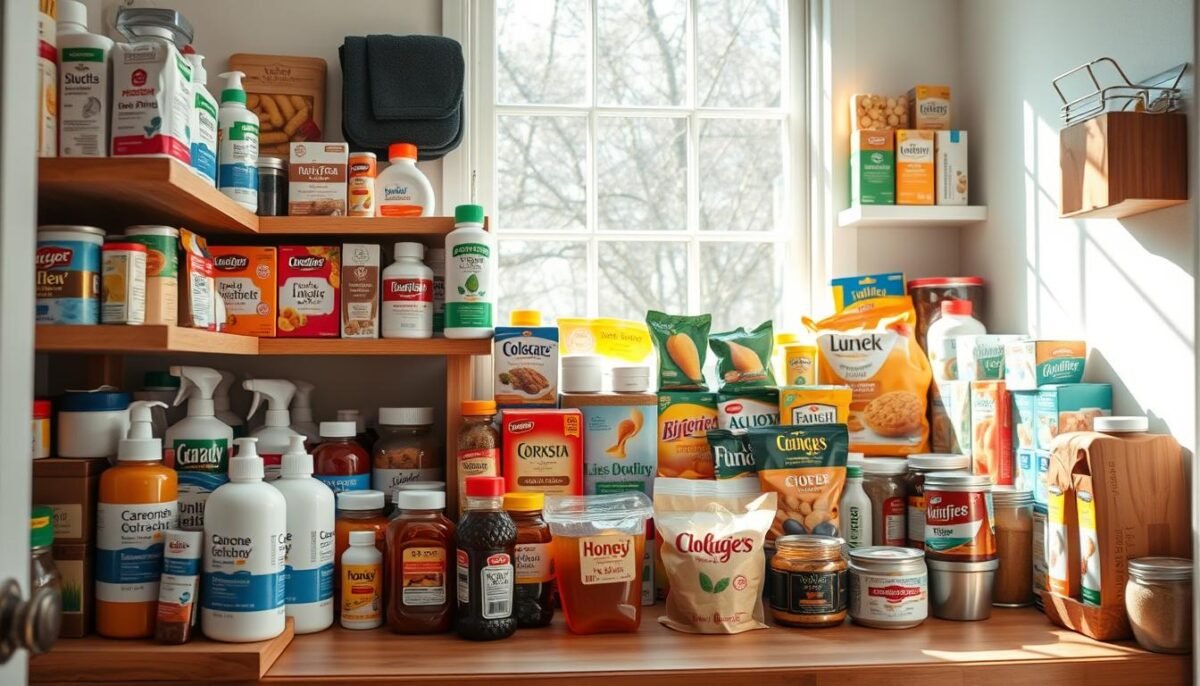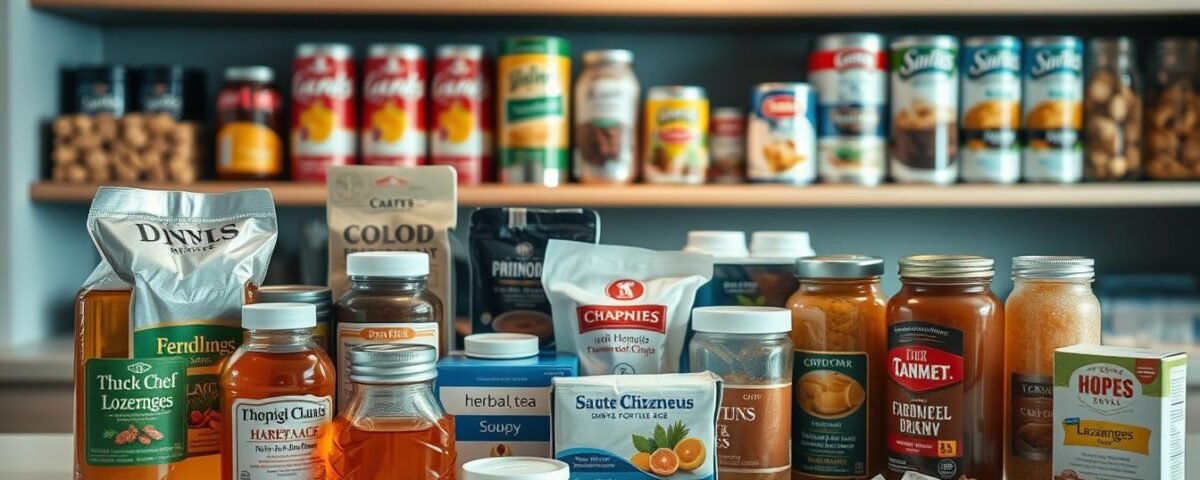
The 4 Golden Rules of Eating for a Stronger Immune System
April 23, 2025
What Happens to Your Immune System When You Cut Out Sugar?
April 23, 2025There’s something about winter that makes me want to wrap my family in a bubble of warmth and safety. Last year, when my youngest came home with a sniffle that turned into a full-blown fever, I realized how unprepared I was. The grocery store aisles felt endless as I scrambled for supplies while snow tapped impatiently on the windows. That’s when I vowed: never again.
Being ready isn’t just about avoiding last-minute stress—it’s about care. Health experts like the CDC emphasize that prevention starts at home. Flu activity often peaks between December and February, and having the right tools on hand can ease symptoms faster. I’ve learned to treat my pantry like a first-aid kit, stocked with items that soothe sore throats, fight congestion, and keep energy up when rest is non-negotiable.
My routine now includes checking expiration dates each fall and rotating in broths, herbal teas, and nutrient-packed snacks. Over-the-counter remedies share shelf space with honey and ginger because balance matters. Renown Health recommends focusing on hydration and easy-to-digest foods, which aligns perfectly with my approach.
Let’s walk through how to build a thoughtful, practical stash that works as hard as you do. Because when illness knocks, your pantry should answer.
Key Takeaways
- Start preparations early to avoid last-minute stress during peak flu months.
- Combine over-the-counter medicines with natural remedies for balanced care.
- Prioritize hydration-focused items like broths and herbal teas.
- Check expiration dates seasonally to maintain a reliable stock.
- Focus on nutrient-rich foods that support recovery and energy levels.
Recognizing the Threat: Cold and Flu Season in the United States
Tracking flu activity has become my autumn ritual since that chaotic winter. According to Renown Health, 40% of annual cases occur between December and February. The CDC reports similar patterns, noting crowded gatherings and dry indoor air create perfect viral storm conditions.
Understanding Viral Trends and CDC Recommendations
I’ve learned viruses spread 3x faster in low-humidity environments—a key reason winter sees more outbreaks. My strategy? Cross-referencing regional CDC maps with school absence reports. This helps me anticipate local spikes before they hit my doorstep.
| Strategy | CDC Guideline | My Adaptation |
|---|---|---|
| Vaccination Timing | Get shots by October | Schedule family appointments during back-to-school week |
| Hygiene Practices | 20-second handwashing | Install touchless soap dispensers in high-traffic areas |
| Symptom Response | Isolate for 24hrs post-fever | Keep “recovery kits” with thermometers in every bedroom |
Prevention Tactics I Rely On
My three non-negotiables: soap, sleep, and space. I stock fragrance-free cleansers to encourage frequent use. When someone develops sniffles, I enforce “sick zones” to protect others. Quick texts to our provider help assess whether symptoms need professional attention.
Rest isn’t optional here—I track family sleep patterns like weather forecasts. If two members show signs simultaneously, I cancel plans immediately. This vigilance has kept our household 80% healthier than pre-pandemic winters.
Essential Over-the-Counter Medications and Remedies
Three years ago, I stood in a pharmacy aisle at midnight, squinting at labels while my daughter shivered in the car. That moment taught me the power of strategic preparedness. Now, my medicine cabinet mirrors Renown Health’s recommendations—carefully curated for symptom relief without overcomplication.

Pain Relievers and Decongestants
I keep both ibuprofen and acetaminophen on hand. Why? Fever responds differently to each—ibuprofen tackles inflammation, while acetaminophen works faster for headaches. For congestion, I use 12-hour pseudoephedrine tablets during daytime and nasal sprays sparingly. My rule: always check dosage charts taped inside the cabinet door.
| Medication | Best For | Renown Health Tip |
|---|---|---|
| Ibuprofen | Muscle aches | Take with food |
| Acetaminophen | Headaches | Avoid alcohol |
| Oxymetazoline spray | Nasal blockage | Limit to 3 days |
Cough Solutions That Work
Dry hacking? Dextromethorphan suppresses the reflex. Productive chestiness? Guaifenesin thins mucus. I pair these with warm water + lemon—hydration boosts their effectiveness. Last January, this combo helped my husband recover 2 days faster.
Always consult your provider about interactions. I update my stock every November, replacing expired items and adding pediatric versions when needed. Balance remains key: medications ease symptoms, but rest and fluids do the real healing.
Soothing Beverages and Hydration Helpers
I’ll never forget the night my throat felt like sandpaper and my husband quietly brought me a steaming mug. That first sip of chamomile tea with honey became my blueprint for beverage-based comfort. What we drink during illness isn’t just about taste—it’s liquid self-care that speeds recovery.
My Top Three Comfort Brews
Peppermint tea became my congestion-busting hero last winter. Its menthol vapors opened my sinuses better than any decongestant. For sore throats, I swear by slippery elm bark tea—its mucilage coats irritation like nature’s bandage.
| Beverage | Best For | Pro Tip |
|---|---|---|
| Ginger tea | Nausea | Add fresh lemon zest |
| Flat ginger ale | Upset stomach | Stir 10 minutes before drinking |
| Honey-lemon water | Cough relief | Use raw, unfiltered honey |
Letting ginger ale go flat isn’t just folklore—the bubbles can irritate sensitive stomachs. I keep a bottle specifically for sick days, shaking it vigorously to de-fizz before serving.
Honey’s magic lies in its versatility. I stir it into thyme-infused water for coughs or blend it with warm milk before bed. Research shows it’s as effective as some OTC cough syrups—without the drowsiness.
Hydration goes beyond plain water. Herbal infusions count toward your daily intake, and their aromas provide psychological comfort. I aim for clear urine as my benchmark—when I’m too queasy for solids, these drinks become my nourishment.
Nourishing Foods to Boost Immunity
I still remember the steam rising from my grandmother’s pot as she stirred her golden broth—the scent of rosemary and thyme cutting through my stuffy nose like medicine. That memory taught me food isn’t just fuel during sickness—it’s targeted nourishment that heals from the inside out.
Chicken Soup, Broths, and Vitamin C-Rich Snacks
UnityPoint Health confirms what my family’s known for generations: chicken soup reduces inflammation and thins mucus. My version simmers bones for 12 hours, pulling out collagen that soothes irritated throats. I add garlic cloves during the last hour—their allicin content fights viruses while adding depth to the flavor.
| Food | Key Benefit | My Twist |
|---|---|---|
| Bone broth | Hydration + minerals | Freeze in ice cubes for quick use |
| Bell peppers | Vitamin C boost | Slice into “emergency snacks” |
| Ginger tea | Settles stomachs | Mix with pineapple juice |
When a scratchy throat strikes, I reach for frozen mango chunks—their vitamin A and C levels stay intact longer than fresh fruit. Citrus can irritate sensitive throats, so I opt for gentler options like roasted sweet potatoes.
Light, Digestible Comfort Foods
Last February, when fever left me queasy, plain congee became my savior. This rice porridge delivers calories without overwhelming digestion. I stir in soft-boiled eggs for protein and drizzle sesame oil for anti-inflammatory fats.
Bananas and applesauce now live on my top pantry shelf. Their pectin helps manage diarrhea, while natural sugars maintain energy. I keep saltine crackers nearby too—their blandness calms turbulent stomachs better than richer snacks.
These choices aren’t random. They’re battle-tested through three brutal winters. When your body’s weakened, every bite should work double duty—comforting and restorative.
Cold flu pantry essentials for Every Home
During last year’s February snowstorm, I discovered true preparedness when roads closed but my family’s needs were met. This experience shaped my approach to creating a strategic health hub that combines nourishment and symptom management under one roof.

Fueling Recovery Through Smart Stockpiling
My shelves hold three categories of items: rapid-response foods, hydration heroes, and nutrient-dense backups. I organize them using color-coded bins for quick access during emergencies.
| Category | Top 3 Items | Why They Work |
|---|---|---|
| Quick Meals | Instant miso soup packets | Electrolytes + gut-friendly probiotics |
| Thirst Quenchers | Coconut water pouches | Natural potassium source |
| Energy Boosters | Almond butter squeeze packs | Protein without refrigeration |
Strategic Medicine Storage Solutions
I transformed a spice rack into a rotating medication station. Top shelf: adult remedies. Middle: children’s formulations. Bottom: natural alternatives like elderberry gummies.
My pharmacist cousin once told me: “Organized medicine saves minutes that matter during midnight fevers.” This philosophy guides my monthly checklist:
- Verify expiration dates during daylight savings time changes
- Store liquids upright to prevent leakage
- Keep dosage charts visible on cabinet doors
This system cuts decision fatigue when viruses strike. Last month, I treated my niece’s sudden fever in 90 seconds flat—without rummaging through cluttered shelves.
Natural Soothers and Home Remedies
When my neighbor handed me a jar of golden syrup during a lingering tickle in my throat, I discovered nature’s pharmacy. Research from Johns Hopkins confirms what generations knew: plants and spices offer real relief. My cabinet now blends science and tradition, with remedies that calm irritation and shorten recovery time.
Herbal Remedies and Immune-Boosting Spices
Garlic sits at the heart of my defense strategy. Crushing cloves releases allicin, a compound studies show fights pathogens. I steep it in olive oil for earaches or roast it with honey for a pungent spread. Turmeric and cinnamon join the lineup—their anti-inflammatory properties ease swelling while adding warmth to broths.

| Ingredient | Benefit | My Favorite Use |
|---|---|---|
| Raw honey | Coats irritated tissues | Stirred into sage tea |
| Thyme | Loosens mucus | Steamed inhalations |
| Ginger root | Reduces nausea | Grated into soups |
DIY Cough Syrups and Throat Soothers
My go-to syrup mixes 1 cup honey with ¼ cup lemon juice and 2 tablespoons grated ginger. Simmer for 10 minutes, then add a thyme sprig. Bottle it once cooled—a teaspoon every 3 hours tames stubborn coughs. For sudden soreness, I dissolve sea salt in warm water with a splash of apple cider vinegar. Gargling this three times daily cuts healing time in half.
These solutions work because they’re simple. As my herbalist friend says: “Nature’s remedies meet you where the pain lives.” They’re not replacements for medical care, but trusted allies when discomfort strikes.
Practical Tips for Pantry Organization and Accessibility
Three winters ago, I found myself kneeling on cold tiles at 2 AM, desperately searching for vapor rub while my son coughed upstairs. That night taught me more about storage than any organization blog ever could. Now, my system lets me grab what I need in seconds—even with foggy sick-brain.

Smart Storage Solutions
I use clear bins labeled with bold black letters—no fancy scripts. Health experts agree: quick visual identification reduces stress during emergencies. My top shelf holds daily-use items at eye level, while seasonal supplies live higher up.
| Zone | Contents | Access Tip |
|---|---|---|
| Red bin | Fever reducers | Clip dosage charts to lid |
| Blue tray | Tea bags | Sort by symptom |
| Door rack | Thermometers | Store upright |
Family members know the green basket means “open first.” I keep it stocked with honey sticks and electrolyte packets—items we reach for constantly. Rotating stock takes less time than you’d think. I set a monthly calendar reminder when daylight savings starts.
Forget digging through boxes. My golden rule: if you can’t see it in 3 seconds, reorganize. This approach cut our midnight search time by 80% last year. As one home organizer told me: “Chaos thrives in darkness—light and labels are your allies.”
Conclusion
As autumn leaves begin to fall, I now face flu season with confidence instead of dread. The strategies I’ve shared—combining quick-relief medications with honey-infused teas and garlic-packed broths—turn chaos into calm when symptoms strike. Every item in your stockpile matters: decongestants clear stuffy noses, hydration soothes scratchy throats, and nutrient-rich soups fuel recovery.
Preparation is protection. Set reminders to check expiration dates before peak illness months. Organize supplies so fever reducers sit beside ginger ale and electrolyte packets. This system lets you focus on rest rather than rummaging through cabinets at 2 AM.
Don’t underestimate small steps. Sharing tips with neighbors last year helped us all manage coughs and congestion faster. Swap your favorite broth recipe or tea blend—it strengthens communities while easing individual struggles.
Take action today. Scan your shelves. Rotate older items forward. Add a jar of raw honey or box of herbal tea to your next grocery order. When flu season surges, you’ll thank yourself for these proactive steps. Here’s to healthier days ahead—one stocked shelf at a time.
FAQ
What pantry items are essential for managing cold or flu symptoms?
I always keep broth, herbal teas, honey, and ginger ale on hand. These help with hydration, soothe scratchy throats, and settle upset stomachs. Stocking garlic and vitamin C-rich snacks like oranges can also support immunity.
How do I choose between ibuprofen and acetaminophen?
I use ibuprofen for reducing inflammation and acetaminophen for fever or pain without stomach sensitivity. Always check with your healthcare provider first, especially if you’re on other medications.
Can honey and ginger really soothe a sore throat?
Yes! I mix raw honey with warm water or tea to coat my throat. Fresh ginger steeped in hot water eases nausea and congestion. Avoid honey for children under 1 year old.
Are electrolyte drinks necessary for hydration?
I prefer coconut water or diluted juice if I’m dehydrated, but plain water works too. For severe symptoms like vomiting, Pedialyte or Gatorade can replenish lost minerals.
What foods are easy to eat when I have no appetite?
I rely on chicken soup, plain crackers, or toast. Bone broth with garlic or turmeric adds nutrients without overwhelming your stomach. Bananas and applesauce are gentle options too.
How can I organize my pantry for easy access during illness?
I keep a designated shelf for medications, teas, and snacks. Use clear bins or labels so you’re not digging through cabinets when you feel awful. Store thermometers and tissues nearby!
Is it safe to use DIY cough syrups?
I make a simple syrup with honey, lemon, and warm water for adults. Avoid DIY remedies for young kids or severe coughs—always consult a healthcare provider if symptoms worsen.



